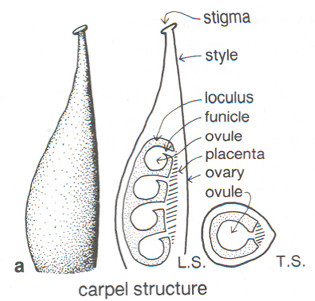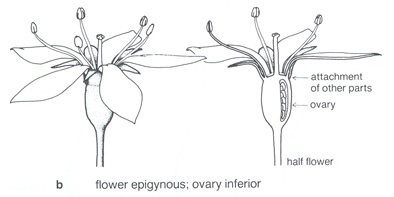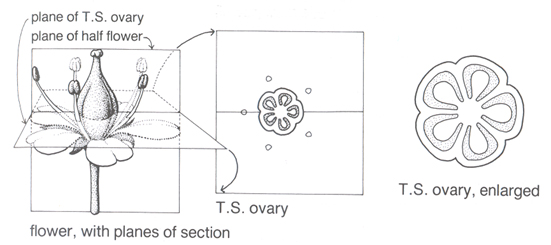Select from the following gynoecium features and view high quality images depicting the feature.
When you are ready, test your understanding and take the gynoecium quiz (see note below).
The gynoecium is the female part of the flower, consisting of one or more carpels.
The carpel is a unit of the gynoecium consisting of ovary, style and stigma:
Illustration from Clarke, I. & Lee, H. (2003) Name that Flower, Melbourne University Press, Victoria.
Carpels are the basic units of the gynoecium and may be free (distinct) or fused (connate). The term pistil is used in a similar manner to carpel – in some situations the terms are equivalent in meaning but not in others. For example, a flower represented by G 1 has a single carpel or a single pistil. A flower represented by G (3) represents three fused carpels but is only a single pistil (compound).

One flower with
In a floral formula this would be expressed G3_

One flower with
In a floral formula this would be expressed G(3)_
If the above is confusing the simplest path is just to use the term ‘carpel’ and avoid the potential ambiguity of using ‘pistil’.
We need to determine if the ovary is superior or inferior.
To determine this a longitudinal section of the flower is needed.
Slideshow examples of superior ovary
If the sepals, petals and stamens, or their united bases (floral tube), arise from below the ovary it is superior. If the sepals, petals and stamens are free from each other the flower is hypogynous (compared with perigynous and epigynous.
In a floral formula a superior ovary is often depicted as follows, e.g. G (3) _. To remember whether the line goes above or below the number it can be useful to consider the number represents the ovary and the line as the point of attachment of the other floral parts.

Illustration from Clarke, I. & Lee, H. (2003) Name that Flower, Melbourne University Press, Victoria.
Slideshow examples of inferior ovary
In an inferior ovary the sepals, petals and stamens, or their united bases (floral tube), are attached to the top of the ovary. In a floral formula the line goes above the G number, e.g. G (3)¯.
Illustration from Clarke, I. & Lee, H. (2003) Name that Flower, Melbourne University Press, Victoria.
Slideshow examples of semi-inferior ovary
In a relatively small number of species the sepals, petals and stamens arise about halfway up the ovary and this is termed half- or semi-inferior.

Illustration from Clarke, I. & Lee, H. (2003) Name that Flower, Melbourne University Press, Victoria.
We also need to determine the number of carpels and the number of loculi in the ovary.
The carpel number can usually be determined by a cross section of the ovary.
Slideshow - Single flower with multiple free carpels
Slideshow - Single ovary with multiple fused carpels
Slideshow - Single ovary with a single loculus

Illustration from Clarke, I. & Lee, H. (2003) Name that Flower, Melbourne University Press, Victoria.
We need to determine whether the style is terminal or gynobasic.
In most species the style extends from the top of the ovary. In some families (e.g. Lamiaceae and Rutaceae) the ovary is lobed and the style is inserted between the lobes.
NOTE: Allow popups from science-health.csu.edu.au in your browser to open the Gynoecium Quiz.
Then return to this page retry the test button.